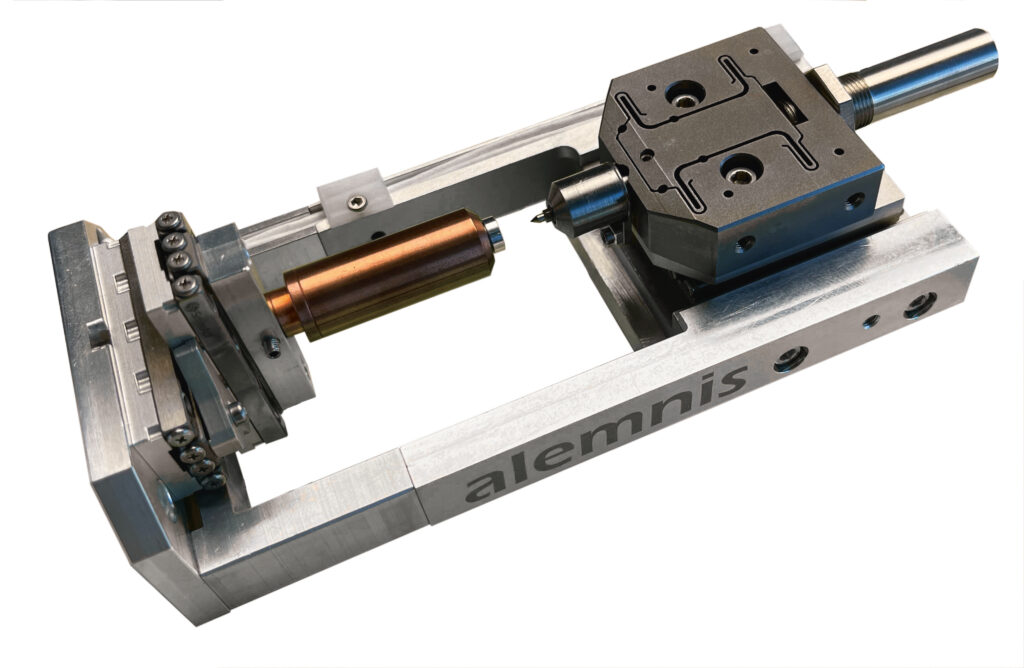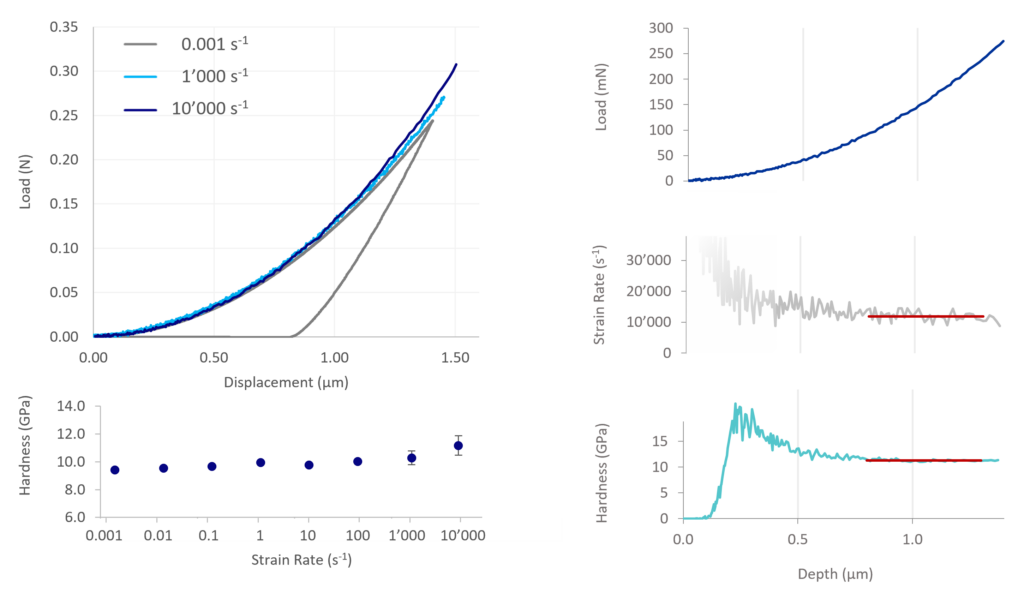Alemnis is the pioneer in the field of microscale high strain rate testing. Based on more than 10 years of experience, Alemnis offers the highest attainable strain rates, perfect control on actuation profiles, unparalleled data acquisition rates, and the highest mechanical stiffness. The Alemnis high strain rate system redefines the boundaries of high strain rate and impact testing, making it the ultimate choice for cutting-edge indentation, tensile, and compression testing with perfect displacement control.
The world’s fastest nanoindenter:
Ultra High Strain Rate Micromechanics

Ultra High Strain Rate (UHS) module
Ultra High Strain Rates from 0.0001 up to 10'000 /s
Nine orders of magnitudes of strain rates for indentation, tensile- and compression testing makes Alemnis the world’s fastest micro mechanical testing system, enabling unprecedented extreme experiments.
Alemnis provides the only high strain rate system that offers:
- Constant and controlled strain rates
- Continuous testing from quasi-static to high strain rates
- Read-out frequency of 1 MHz for displacement and load.
- Direct data analysis without complicated modelling or system assumptions

Figure 1 | Strain rate (s-1) is the inverse value of the time it takes to perform the mechanical loading. As a result, experiments take as little as 0.1 ms at maximum strain rates.
High Strain Rates Nanoindentation
High strain rates testing of materials is of great interest, both in industrial applications and in fundamental research as it provides insights into mechanical properties of materials under extreme conditions. Although the nanoindentation technique has evolved in recent years, most tests are still typically performed in the quasi-static regime. The Alemnis High Strain Rate system performs nanoindentation one million times faster than standard testing conditions!

Figure 2 | Nanoindentation on fused silica across 8 orders of magnitudes. At strain rates above 100 s-1, Hardness is calculated using the contact stiffness obtained at quasi-static conditions. This widely accepted method circumvents the issue of unreliable unloading curves at extreme strain rates by assuming that the elastic properties are independent of the applied strain rate.
High Strain Rates Micro-Compression
Testing materials under compression offers a straight-forward approach to determining yield strength, deformation behaviour, and failure mechanisms. At the microscale, compression testing is most commonly performed on focused ion-beam (FIB) milled or micro-3D-printed structures, but also lithographic approaches have proven suitable. Alemnis enables testing of such structures continuously from quasi-static up to high strain rates across 7 orders of magnitude (10-3–103 /s) with true displacement control. This means constant strain rates, controlled strain levels, and no strain bursts at load drops.

Figure 3 | Silicon micropillar compression across 6 orders of magnitudes of strain rates on lithographically produced pillars (height = 5 µm, diamteter = 1.8 µm). No unloading segment is recorded as Si fails in a brittle manner.
High Strain Rates combined with Environmental Control
High strain rates can also be achieved at high or low temperatures, as well as under controlled relative humidity. This enables unique experiments in the field of biomechanics, metallurgy, of bone and other tissues in the context of biomechanics. This interdisciplinary approach is crucial for understanding the dynamic behavior of bone properties under conditions such as impact or sudden loading, while considering the physiological context. This knowledge can have implications for fields ranging from sports science to injury prevention, where a thorough understanding of bone behavior in dynamic conditions is essential.
- Variable temperature from -150 °C up to 1000 °C
- Relative humidity from 5 – 90 % at 25 – 70 °C
- Gases, full immersion in liquids, electrical testing

Figure 4 | Left: Strain rate dependent yield stress of nanocrystalline nickel at –120 °C [1] Right: High strain rate stress-strain curves recorded under controlled humidity of 90% RH [2].
Comparison with Macroscale Testing
Investigations into the response of materials to deformation at high strain rates are imperative for comprehending their behaviour under dynamic conditions. Research across metal shaping, machining, crashworthiness, projectile impact, and beyond, indispensably rely on a solid understanding of material behaviour under high strain rates. Performing this type of measurements at the macroscale offers a broader perspective on overall material behaviour. Microscale testing, on the other hand, provides high spatial resolution and sensitivity to microstructural changes and local effects. The two approaches can therefore be seen as complementary.
In practice, there are several conveniences offered by microscale high strain rate testing:
- Accurate control on imposed strain
- Precise control on displacement profiles (constant speed, exponential loading, etc.)
- Continuous sweep from quasistatic up to ultra high strain rates
- High throughput testing on a small volume of material
- Surface material properties including thin films and ion irradiated volumes
- Testing individual grains with different crystallographic orientations
- Testing material interfaces (grain boundaries, composites, ceramic-metals, etc.)
- Nanoindentation, compression, and tensile testing in one single machine

System Overview
The Alemnis High Strain Rate line is a modular and adaptive system. The dedicated force sensor and piezoelectric actuator are easily installed on the Alemnis Standard Assembly by the user when required.

Reference customers & publications
The Alemnis High Strain Rate line is a modular and adaptive system. The dedicated force sensor and piezoelectric actuator are easily installed on the Alemnis Standard Assembly by the user when required.

Selected References
- Y. Kai, S. Dhulipala, R. Sun, J. Lem, W. DeLima, T. Pezeril, and C. M. Portela, Dynamic diagnosis of metamaterials through laser-induced vibrational signatures, Nature 623 (2023) 514-521. https://doi.org/10.1038/s41586-023-06652-x
- N. M. della Ventura, P. Schweizer, A. Sharma, M. Jain, T. E. J. Edwards, J. J. Schwiedrzik, R. E. Peruzzi, C. Logé, J. Michler, and X. Maeder, Micromechanical response of pure magnesium at different strain rate and temperature conditions: twin to slip and slip to twin transitions, Acta Materialia 243 (2023) 118528. https://doi.org/10.1016/j.actamat.2022.118528
- R. Ramachandramoorthy, S. Kalácska, G. Poras, J. Schwiedrzik, T. E. Edwards, X. Maeder, and J. Michler, Anomalous high strain rate compressive behavior of additively manufactured copper micropillars, Applied Materials Today 27 (2022) 101415. https://doi.org/10.1016/j.apmt.2022.101415
- R. Ramachandramoorthy, F. Yang, D. Casari, M. Stolpe, M. Jain, J. Schwiedrzik, and J. P. Best, High strain rate in situ micropillar compression of a Zr-based metallic glass, Journal of Materials Research 36 (2021) 2325-2336. https://doi.org/10.1557/s43578-021-00187-5
- R. Ramachandramoorthy, J. Schwiedrzik, L. Petho, C. Guerra-Nunez, D. Frey, J. M. Breguet, and J. Michler, Dynamic plasticity and failure of microscale glass: Rate-dependent ductile–brittle–ductile transition, Nano Letters 19 (2019) 2350-2359. https://doi.org/10.1021/acs.nanolett.8b04842
References in text:
[1] J. Schwiedrzik, R. Ramachandramoorthy, T. E. Edwards, P. Schürch, D. Casari, M. J. Duarte, and J. Michler, Dynamic cryo-mechanical properties of additively manufactured nanocrystalline nickel 3D microarchitectures, Materials & Design 220 (2022) 110836. https://doi.org/10.1016/j.matdes.2022.110836
[2] C. Peruzzi, R. Ramachandramoorthy, A. Groetsch, D. Casari, P. Grönquist, M. Rüggeberg, and J. Schwiedrzik, Microscale compressive behavior of hydrated lamellar bone at high strain rates, Acta Biomaterialia 131 (2021) 403-414. https://doi.org/10.1016/j.actbio.2021.07.005

REQUEST A QUOTE
Please fill in the boxes on the contact form and a member of the team will contact you directly for a quotation.
Each quotation will be unique to the customer requirements so please give as much information in the contact form as possible, this will enable us to get the most accurate price back to you.


